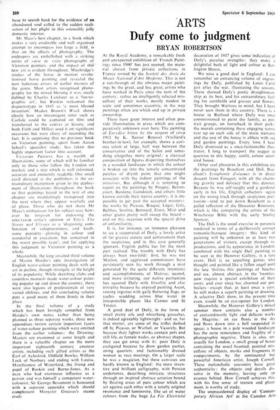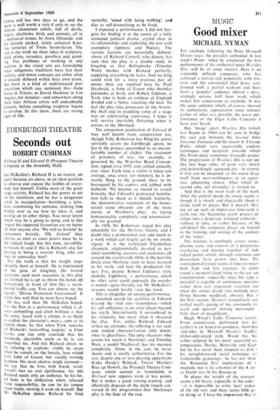ARTS Dufy come to judgment
BRYAN ROBERTSON
At the Royal Academy, a remarkably fresh and unexpected exhibition of 'French Paint- ings since 1900' has just opened, the mate- rial chosen from private collections in France owned by the Societe des Antis du Musee National d'Art Moderne. This is not a run-through of the obvious major paint- ings by the great, and less great, artists who have worked in Paris since the turn of the century: rather an intelligently selected mis- cellany of their works, mostly modest in scale and sometimes eccentric, in the way paintings often are which end up in private ownership.
These have great interest and often pro- vide illumination in areas which are com- paratively unknown over here. The painting of Eurydice bitten by the serpent of circa 1913 by K. Xavier Roussel (Vuillard's brother-in-law), for example, shows a curi- ous talent at large, half way between the conservative end of the Salon and some- thing altogether more original: a classical composition of figures disporting themselves in a wooded landscape in which the colour is broken up into the tensely concentrated patches of dryish paint that one might associate with the indoor paintings of the intimistes. But although it is tempting to report on the paintings by Pougny, Betten- court. Bardone, Gondouin, and others little known outside their native country, it is im- possible to get past the accepted masters: the works by Picasso, Braque, Leger, Gris, Balthus, Soutine, Bonnard, Ernst, Miro and other giants pretty well sweep the board— and on this occasion with the special drive of unfamiliarity.
It is, for instance, an immense pleasure to see a reappraisal of Dufy, a lovely artist of far greater stature and achievement than the suspicious, and in this case generally ignorant, English public has for the most part realised. The trouble with Dufy has always been two-fold: first, he was not Matisse, and aggrieved connoisseurs have persistently seen his work through a mist generated by the quite different intentions and accomplishments of Matisse; second, and more irritating, our native puritanism has equated Dufy with frivolity and chic triviality because he enjoyed painting Ascot, rowing regattas with gaily fluttering flags, or yachts scudding across blue water in irresponsible places like Cannes and St Tropez.
A good deal of Dufy, in the form of small pretty oils and whizzbang gouaches, is indeed agreeably lightweight—and so, for that matter, are some of the trifles dashed off by Picasso, or Warhol, or Vasarely. But because their lighter works contain pots and still life, or female nudes, or abstract shapes, they can get away with it: poor Dufy is castigated because he drew garden parties, string quartets, and fashionably dressed women at race meetings. On a larger scale he was a magician, but these canvases are hardly known in England: the most inven- tive and brilliant calligraphy, with Persian undertones, describing intricate structures through an inspired abstract notation bound by floating areas of pure colour which are set against each other with a totally original resonance and luminosity. The set of water colours from the huge La Fee Electricite
decoration of 1937 gives some indication of Dufy's peculiar strengths: they make a delightful bath of light and colour at Bur- lington House.
We miss a good deal in England: I can remember an entrancing volume of engrav- ings by Dufy, published by Louis Carre just after the war, illustrating the seasons. These showed Dufy's poetic draughtsman- ship at its best, and his extraordinary feel- ing for cornfields and grasses and flowers. They brought Watteau to mind, but I have never seen them in this country. There is a house in Rutland where Dufy was once commissioned to paint the family, as por- trait groups, on horseback in their park: the murals containing these engaging scenes rear up on each side of the main staircase and the rest of the house is ablaze with sea and garden paintings. Every time 1 hear Dufy dismissed as a once-fashionable illus- trator, I long to transport the nagger in question to this happy, sunlit, colour satur- ated house.
Other real pleasures in this exhibition are the paintings by Bauchant and Dali. Bau- chant's Symphonie d'oiseaux is in direct descent from Fouquet, with all the charm- ing gravity and delicacy that this denotes. Because he was self-taught and a gardener early in his life, English collectors—again on the wrong track through suspicious puri- tanism—tend to put down Bauchant as a pallid reflection of the Douanier Rousseau, which is like comparing the artists of the Winchester Bible with the early Stanley Spencer.
The Dali is the usual exercise in paranoia rendered in terms of a deliberately corrupt romantic-baroque imagery: this kind of painting will be unknown to at least two generations of visitors, except through re- productions, and its appearance in London, combined with the single Dali painting to be seen at the Hanover Gallery, is a rare event. Dali is an appalling genius who thought and painted like a fallen angel until the late 'thirties (his paintings of beaches and sea, almost abstract, in the 'twenties, now require a special exhibition of their own), and ever since has churned out pot- boilers—except that, at least once a year, he still makes a superb painting or drawing. A selective Dali show, to the present time even, would be an eye-opener for London.
Meanwhile, the Hanover Gallery's mixed summer show contains also a number of extraordinarily light and delicate works by Magritte: an ear floats in the sky and flows down into a bell suspended in space; a house in a pale wooded landscape has the eerie remoteness and fragility of a photographic negative. There is also, un- usually for London, a small group of boxes containing the usual haunted, pointed mis- cellany of objects, marks and fragments in compartments, by the sentimental but powerful American artist, Joseph Cornell. These melancholic souvenirs have great authenticity: the objects and details dis- solve in the memory, leaving only an essence behind. How Cornell achieves this, with his fine sense of texture and place- ment, is worthy of study.
The unprecedented display of 'Contem- porary African Art' at the Camden Arts Centre still has two days to go, and the show is well worth a visit if only to see the delicate aluminium reliefs, full of devils, angels, chieftains, birds and animals, all in a mediaeval trance, by Asiru Olatunde, and the densely packed, richly coloured K lee- like fantasies of Twins Seven-Seven. The rest of the work on show takes in sculpture, batik prints, ceramics, jewellery and paint- ing. The problems of working in any medium in the visual arts are formidable when indigenous traditions have lost their %alidity, and newer concepts are either alien or already debased within their own terms. But there is a kind of sophisticated pro‘' vincialism which can surmount this—Italo Svevo in Trieste, or David Hockney in Los Angeles, for instance—and somewhere along these lines African artists will undoubtedly triumph, before something weightier begins to develop. In this show, there are strong signs of life.



































 Previous page
Previous page